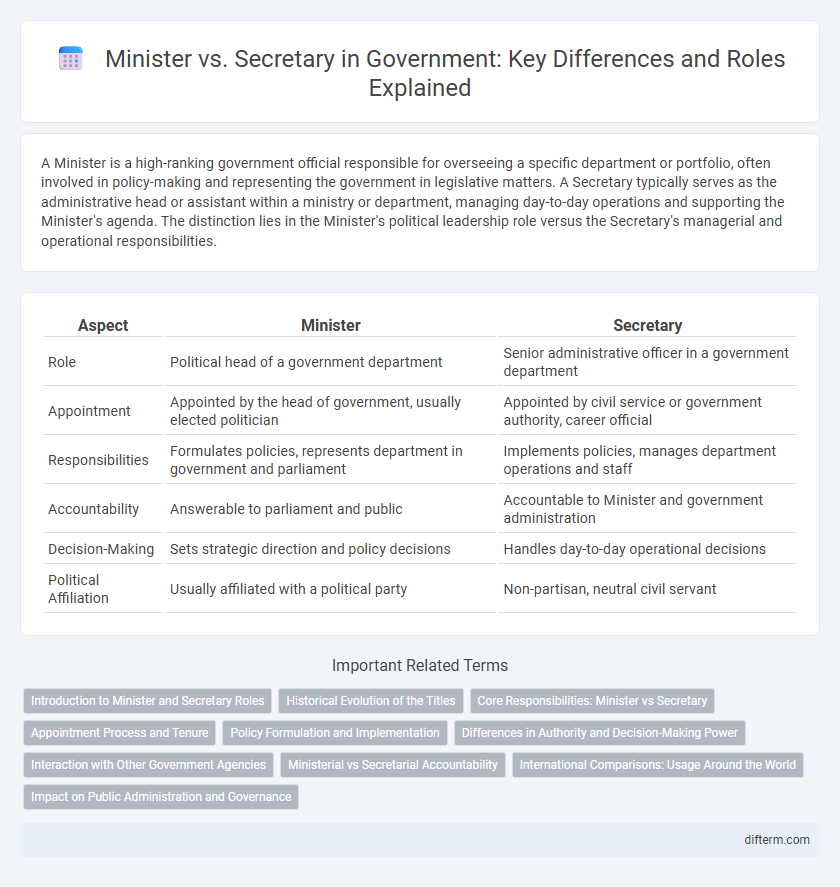A Minister is a high-ranking government official responsible for overseeing a specific department or portfolio, often involved in policy-making and representing the government in legislative matters. A Secretary typically serves as the administrative head or assistant within a ministry or department, managing day-to-day operations and supporting the Minister's agenda. The distinction lies in the Minister's political leadership role versus the Secretary's managerial and operational responsibilities.
Table of Comparison
| Aspect | Minister | Secretary |
|---|---|---|
| Role | Political head of a government department | Senior administrative officer in a government department |
| Appointment | Appointed by the head of government, usually elected politician | Appointed by civil service or government authority, career official |
| Responsibilities | Formulates policies, represents department in government and parliament | Implements policies, manages department operations and staff |
| Accountability | Answerable to parliament and public | Accountable to Minister and government administration |
| Decision-Making | Sets strategic direction and policy decisions | Handles day-to-day operational decisions |
| Political Affiliation | Usually affiliated with a political party | Non-partisan, neutral civil servant |
Introduction to Minister and Secretary Roles
Ministers are high-ranking government officials responsible for specific departments, shaping policy and overseeing implementation at a national or regional level. Secretaries often serve as senior civil servants or administrative heads within ministries, managing day-to-day operations and advising ministers. Both roles are crucial for effective governance, ensuring that policy decisions translate into actionable programs and public services.
Historical Evolution of the Titles
The historical evolution of the titles Minister and Secretary reflects distinct governmental functions shaped by tradition and administrative reforms. Ministers originated in European monarchies as high-ranking officials managing specific state departments, while Secretaries emerged in English administrative systems as key advisors and record keepers evolving into cabinet-level roles. Over time, the Minister title became prevalent in parliamentary democracies to denote political leadership, whereas Secretary often designates senior bureaucrats or heads of departments in presidential systems like the United States.
Core Responsibilities: Minister vs Secretary
Ministers primarily shape government policies, represent their departments in the cabinet, and oversee broad strategic objectives. Secretaries focus on administrative management, ensuring that government programs and services are effectively implemented and comply with regulations. The Minister sets the vision and political direction while the Secretary manages daily operations and executes the Minister's decisions.
Appointment Process and Tenure
Ministers are typically appointed by the head of state or government, often requiring parliamentary approval or confirmation hearings, while Secretaries are usually appointed by the executive branch, sometimes with legislative endorsement depending on the country's system. The tenure of a Minister is often tied to the term of the government or Prime Minister, and they may serve at the pleasure of the appointing authority, whereas Secretaries may have fixed terms or serve at the discretion of the executive depending on statutory or constitutional provisions. Appointment processes and tenure length differ significantly across countries based on legal frameworks and political structures.
Policy Formulation and Implementation
Ministers hold primary responsibility for policy formulation, setting strategic priorities, and providing political leadership within their respective government departments. Secretaries focus on policy implementation, ensuring administrative efficiency, managing departmental operations, and translating ministerial directives into actionable programs. The collaboration between ministers and secretaries is crucial for aligning government objectives with effective public service delivery.
Differences in Authority and Decision-Making Power
Ministers typically hold higher authority and have broader decision-making power within government cabinets, overseeing entire departments or ministries. Secretaries usually function as senior administrative officers or heads of specific agencies, implementing policies under ministerial direction. The distinction lies in ministers shaping policy and setting strategic agendas, while secretaries manage operations and execute government directives.
Interaction with Other Government Agencies
Ministers typically engage at a strategic level, coordinating policies and representing their departments in intergovernmental councils, ensuring alignment with national priorities. Secretaries manage operational communications between ministries and agencies, facilitating information flow and implementation of decisions. Effective interaction between Ministers and Secretaries enhances cohesive governance and policy execution across government bodies.
Ministerial vs Secretarial Accountability
Ministerial accountability requires government ministers to answer directly to the legislature and public for departmental policies and decisions, ensuring political responsibility. Secretarial accountability pertains to civil servants or secretaries who are accountable for the administration and implementation of government policies, maintaining operational transparency and efficiency. The distinction emphasizes ministers' political accountability versus secretaries' administrative responsibility within government structures.
International Comparisons: Usage Around the World
Minister and Secretary titles vary significantly in government structures worldwide, with Ministers commonly leading government departments in parliamentary systems like the UK, Canada, and Australia, while Secretaries often serve as heads of executive agencies or departments in presidential systems such as the United States. In countries like India and South Africa, Ministers are political appointees overseeing policy, whereas Secretaries act as top civil servants managing administrative functions. This distinction reflects differing governance frameworks, with Ministers focusing on policy direction and Secretaries on implementation and bureaucratic management across international contexts.
Impact on Public Administration and Governance
Ministers hold political authority as cabinet members, shaping policy direction and public governance through legislative agendas and executive decisions. Secretaries, often senior civil servants, manage departmental operations and implement ministerial policies, ensuring administrative efficiency and continuity in public services. This division of roles balances political leadership with bureaucratic expertise, enhancing transparent governance and effective public administration.
Minister vs Secretary Infographic

 difterm.com
difterm.com